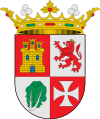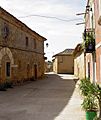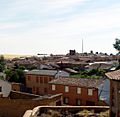Valdunquillo facts for kids
Quick facts for kids
Valdunquillo
|
||
|---|---|---|
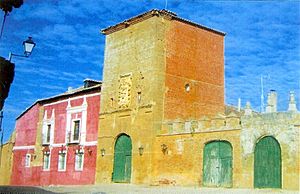
Palace of the Dukes of Alba
|
||
|
||
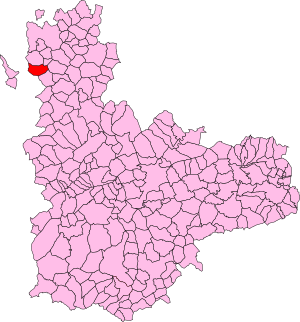
Location of Valdunquillo
|
||
| Country | ||
| Autonomous community | ||
| Province | Valladolid | |
| Comarca | Tierra de Campos | |
| Judicial district | Medina de Rioseco | |
| Founded | See text | |
| Area | ||
| • Total | 30.8 km2 (11.9 sq mi) | |
| Elevation | 741 m (2,431 ft) | |
| Population
(2018)
|
||
| • Total | 133 | |
| • Density | 4.318/km2 (11.18/sq mi) | |
| Time zone | UTC+1 (CET) | |
| • Summer (DST) | UTC+2 (CEST) | |
| Postal code |
47672
|
|
| Dialing code | 983 | |
| Official language(s) | Spanish | |
Valdunquillo is a small town, called a municipality, in Spain. It is located in the province of Valladolid, in the region of Castile and León. Today, about 133 people live in Valdunquillo (2018 data).
People from Valdunquillo are traditionally called "lechugeros." This nickname means "lettuce growers." It shows that the town was famous for its tasty lettuce. Valdunquillo is close to other towns like La Unión de Campos and Medina de Rioseco.
Contents
A Look Back: Valdunquillo's History
Valdunquillo has a long and interesting history. Different groups of people have lived here over time. These include Christians, Jews, and Muslims.
Scientists believe the first people to live in this area were the Vaccaei. They were an ancient group of people.
The town is first mentioned in a written paper from 1126. This paper talks about a gift from a noblewoman named Countess Doña Mayor. In another old paper from 1192, the town is called "Valle de Junquello." This might be where its current name comes from.
In 1368, King Enrique II gave the town to Alvar Pérez Osorio. The Osorio family played a big part in the town's history. They helped build the town's convent. Later, in 1623, King Philip IV of Spain made Francisca de Valdés Osorio the first Marchioness of Valdunquillo.
Exploring the Town of Valdunquillo
The buildings in Valdunquillo are mostly made of adobe (a type of mud brick) and regular bricks. They have tile roofs. This style is very common in the Castile region of Spain. You can also see many "palomares," which are traditional dovecotes (buildings for pigeons).
Valdunquillo is part of an area called Tierra de Campos. This region has a rich past. After the Vaccaei, the Romans lived here. Then came the Goths. During the Middle Ages, this area was a border between Muslim and Christian lands.
In the Medieval era and the Renaissance, Tierra de Campos was very important. It was known as the "breadbasket of Spain." This means it grew a lot of food for the country. Over time, the area became less important. Many people moved away to bigger cities like Valladolid and Madrid.
Important Buildings and Monuments
Valdunquillo has several historical buildings. They tell stories about the town's past.
- Convento de la Merced: This convent was started in 1607. A convent is a place where religious people live. Today, this building is used as the San Pedro Church. The brick building was built in the 1700s. Its outside looks simple, but inside it is very fancy. It has golden altars and beautiful religious art.
- Palace of the Dukes of Alba: This small palace is at least from the 1600s. It used to belong to the Osorio family. Their family symbol is carved above the main door. For a long time, the palace belonged to the Duchess of Alba. She was a descendant of the Osorio family. The Duchess was also the Marchioness of Valdunquillo. Now, the palace has been fixed up and is a private home.
- San Pedro Church: This church was built in the 1700s. Today, only the ruins of its tower are left. People in the town call it "The Fallen Tower."
- Santa María Church: This church was built in the 1500s. It is also in ruins now and is private property. You can still see its beautiful mudéjar-style arch. Two cupolas (dome-shaped roofs) also remain.
Images for kids
See also
 In Spanish: Valdunquillo para niños
In Spanish: Valdunquillo para niños


